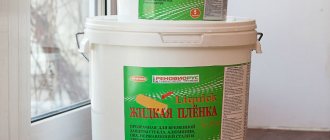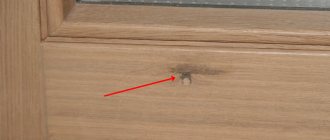Plastic windows are a modern solution for any home. But after installation, you should not expect that the issue will be completely closed. In fact, double-glazed windows can cause serious inconvenience, for example, they can leak. This is usually found during heavy rain. As a result of the inspection, as a rule, it turns out that the leak is not accidental. If this happens, you need to call a specialist, and if this is not possible, independently find out the reason why the plastic window is leaking and find a way to eliminate it.
Why is the window leaking?
There are several reasons for leaky windows:
- Installation error. One of the most common reasons, which can occur both if you installed the windows yourself and if non-professionals did the work. The technology for installing metal-plastic bags is quite complex, and it only takes one mistake when installing the seal or sealing the seams, and during each more or less heavy rain, your window will begin to “cry”.
- Error installing slopes. Not only can the window itself be installed incorrectly, you can also make a mistake when creating slopes. This is not as critical as an installation error, but also leads to incomplete tightness of the structure.
- Old seal. A layer of sealing rubber is responsible for ensuring that the window does not leak. Over time, it cracks, dries out and becomes unusable, and air and water begin to penetrate into the house. Moreover, the window does not even have to be old for such a problem to arise; it simply may not be of the highest quality. Cheap windows with poor seals can begin to leak less than a year after installation.
- The openings are poorly sealed. This means that there is little foam in the openings between the window frame and the wall. It could have dried out over time or it might not have been poured in sufficient quantities initially, but the result is the same – leaky windows.
- Poor quality of the window itself. This also happens, and in this case no repair or debugging work will save you. Therefore, be very careful when choosing a new window design; do not trust little-known manufacturers offering super-quality for pennies, this does not happen. You always have to pay for quality.
Sometimes you can determine the cause of a window leak “by eye,” sometimes you will have to completely disassemble the frame, look at the condition of the seal, and check the slopes and sashes. In any case, before you begin to solve the problem, you should find out its cause. In the end, the problem may not even be in the window, but in a clogged drainage that should drain water from the windowsill.
By the way, water on the inside of a window does not always mean that it is leaking. It could be simple condensation, and then you may have problems not with the window, but with ventilation in the room, and this is a completely different problem and other solutions.
Unfair installation
Poor installation of the window frame leads to drafts in the winter and the appearance of moisture. The appearance of condensation is allowed only during repair work, since many building materials release moisture during drying. During window installation, improper insulation and sealing of the seams is possible, which causes leakage, which can be corrected by high-quality repair of the plastic window.
Other possible causes of window leaks:
- Over time, the sealant loses its properties, dries out and cracks;
- the slopes are made incorrectly;
- problems with polyurethane foam arise when there is insufficient quantity or low quality;
- clogging with debris or low capacity of the drainage system.
How to stop it from leaking
If the problem is in the installation, it is very difficult to fix it. You will have to completely disassemble the structure and then reassemble it, but in compliance with all the rules and technologies. If you understand that you cannot cope with this yourself and will make mistakes again, then it is better to seek help from specialists. Problems with slopes are also an installation issue, and only the one who made these slopes can correct the situation.
With a sealant and polyurethane foam, everything is somewhat simpler. Poor-quality or failed sealing rubber is very easy to distinguish visually - it will be dry, cracked, and loosely adjacent to the frame. In this case, you will simply need to dismantle the seal and attach a new, better one. By the way, in order to make such a replacement less often, you should lubricate the seal with a special agent or Vaseline at least once every six months, then it will dry out less. With polyurethane foam, everything is generally extremely simple - pick out the old one, blow in the new one.
The problem with drainage is also easy to solve on your own, just remove the blockage.
If none of the above methods helped, then the problem is in the window. There are several options here too. Perhaps the whole point is in incorrectly adjusted sashes, and water leaks through them during rain. In this case, you need to take a special tool and tighten the doors. Or maybe the problem is precisely in the quality of assembly and individual elements of the window structure. Then the simplest, although not cheap, solution would be to completely dismantle the window and install a new one of better quality in its place.
Replacing the desiccant in a double-glazed window
As a rule, the service life of the window, as well as whether condensation will occur inside the glass unit, is also influenced by the quality and presence of a desiccant in the spacer frame of the glass unit and sealing layers. If the desiccant is of poor quality, has lost its properties over time, or is missing altogether, then it is not surprising that moisture will collect. In this case, you can try to replace it yourself and repair the double-glazed window with water . To do this you need:
- Remove the glazing beads from the window and pull the glass unit out of the frame.
- Take a drill, put a stop on it and drill a small hole in the spacer frame. This must be done carefully so as not to completely break through the spacer frame.
- After this, you need to pour out the deteriorated desiccant, twist a small funnel from a sheet of paper, insert it into the hole and pour a new desiccant into the spacer frame.
- Then the hole must be sealed with sealant.
- Finally, the glass unit is installed in place.
After completing this work, as a rule, the problem with the occurrence of condensation inside the double-glazed window must be resolved.
It should also be noted that after the glass unit has been removed from the frame, it is necessary to inspect it for depressurization. If there is a place where the seal of the glass unit has been broken, it must be cleaned of dirt and cleared to the spacer frame. After this, you need to dry the glass unit with a regular hairdryer and cover the damaged area with sealant. After these manipulations, should no longer appear in the glass unit
Plastic windows leak
Having visited two applications, I conclude: indeed, water from outside penetrates into the room through a plastic window when closed.
"What to do? Is it really time to replace old plastic windows with new plastic windows?” - clients ask. My answer: “In no case - this is a solvable problem without such extremes! "
And now I will tell you what is happening and why the plastic window is leaking.
In 90% of cases, water during slanting rain penetrates into the room through the gap between the sash and the frame (frame). STOP! “Where are the drainage holes in the frame to drain moisture back to the street? “But what about the sealing rubber - TWO WHOLE CIRCUITS! “- even not very advanced users of plastic windows will ask angrily.
The seal has dried out
The glass unit has a thin rubber layer - a seal. If it wears out, cracks, and stops performing its functions, windows begin to leak when it rains. What to do?
Even before installing the structure, it is recommended to check the service life of the seal. Some manufacturers use polymers that are sensitive to sudden temperature changes and ultraviolet radiation. After a sunny summer or a particularly cold winter, the windows on the balcony leak when it rains, because the rubber in the frame has become unusable, lost its plasticity, and microscopic tears have appeared in its structure.
“I answer in order.”
There have been cases where drains were milled incorrectly at the factory and had no way out, that is, moisture filled the profile chambers where it froze inside at low temperatures! !! Or the drains were clogged with chips after milling (drilling).
Or. ATTENTION! They stupidly forgot to drill them! And what ? — in the early 2000s there were garage productions in Russia like mushrooms after the rain! Therefore, no one particularly bothered to comply with technology.
So check for drainage at your windows.
To be honest, the reason for the drainage holes is less relevant than WHAT YOU READ NEXT.
2. AND HERE IS THE MOST COMMON CAUSE OF LEAKING IN PLASTIC WINDOWS - a failed sealing rubber! This happens after five to seven years. The rubber dried out, became deformed, roughly speaking, it became like oak. Accordingly, through such a “seal” almost unhindered, in addition to water, cold air, dust and noise from the street also pass through.
And if you still think that “some kind of rubber band cannot affect the entire window. "
“AS IT CAN!” «
I strongly recommend reading my article on this topic https://oknatuning.ru/?m=81)
With such defects, the meaning of plastic windows is completely lost!
I'LL START WITH A STORY about how literally today I solved these problems with my own hands.
Taking about a hundred meters of super-anti-blown tires with me, I come to my first client. The puddles of water after the rain were removed from the windowsill, but there was still fresh water inside the frame.
So. DIAGNOSTICS. The windows are eight years old. KVE profile. The ROTO fittings work flawlessly. There are sufficient pressure points around the perimeter. The overlap of the sash on the frame is perfect. Rubber is worthless single-petal. All clear! . Just in case, I check the operation of the training holes - I pour water from a glass into the profile - the water comes out in a vigorous stream.
Conclusion: Plastic windows leak through a broken rubber seal. The drains cannot cope with the flow of rain and the water entering the frame through the first circuit of the non-working seal flows into the room through the second circuit of the same quality. REPLACEMENT OF THE RUBBER SEAL IS REQUIRED! All!
Eight doors, fifteen minutes each - two hours later I was already leaving another happy client. Something like that!
The problem is GUARANTEED fixed! Tested a hundred times!
Do you want to be a happy customer? Then call right now - stop standing by the window with a rag!
What to do if plastic windows sweat and leak?
Eliminating window fogging is a simple task if you remember the following rules:
- Try to ventilate the room regularly. Especially in winter, when the air outside is dry. In this case, it will work as a “blotter”, collecting excess water.
- If you do not have the opportunity to open the shutters for ventilation, vents, transoms, and special fittings are suitable, thanks to which the product partially opens.
- Install window and wall valves to reduce condensation.
- Installing a dehumidifier or ventilation will help regulate humidity.
- Elimination of fogging of plastic windows in housing under construction is possible with the help of “heat guns”. This type of heating encourages water vapor to move around the room to find a cooler spot. But when using a gun, the room must be ventilated so that the air masses come out without settling on the glass.
Don't skimp on quality ventilation. This is one of the simple, affordable methods to normalize humidity levels. This will allow oxygen, which is dominated by steam, to be removed to the outside, replacing it with a drier stream coming from outside. You can choose natural, mechanical or combined ventilation.
An effective option is mechanical (forced) ventilation. It is equipped with a supply mechanism, removing moist air through door, window openings and other openings. You can choose an exhaust method, which allows you to replenish the air supply through openings or fences, removing a certain amount of moisture flow. You can always choose a combined option - experts will tell you what will work in your case.
How can you get rid of condensation on plastic windows?
Window fogging occurs in the cold season, when the air temperature outside and in the apartment is significantly different. Glass is slightly cooler than the air in the room, and upon contact with its surface, water vapor turns into liquid, falling in the form of dew, which is condensation. The drops then become heavy and roll down onto the window profile and sill, where a puddle of water forms. Sometimes there is so much moisture on the windows that it flows onto the floor. Whether this phenomenon will occur depends on many factors.
Why do plastic windows “cry”, and how to get rid of it?
There can be many reasons why plastic windows “cry” and “sweat” from the inside:
✅ Increasing indoor air humidity - for example, when cooking, drying clothes, and so on.
✅ Air circulation violations in the apartment. If in winter the radiators are only slightly warm, and it is very cold outside, then the plastic windows cannot be heated to the proper extent.
✅ If the batteries are hot and the windows still fog up, you need to check the window sill - the window sill is too wide and blocks the heat supply to the window area. Protective screens on batteries can also lead to this - because in this way the heat spreading throughout the apartment does not cover the lower part of the window, which is why condensation forms here.
✅ Lack of high-quality ventilation - it may become clogged or not work at all, so moist air cannot be extracted.











